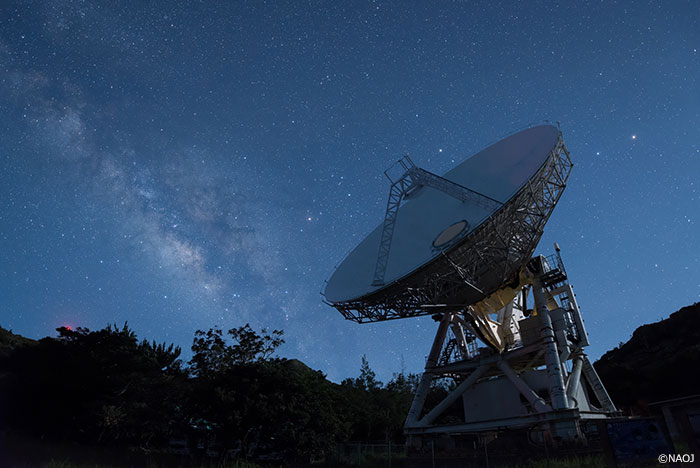VERA Ogasawara Station 20-m Radio Telescope and the Milky Way
Night Scape Photograph・

| Date | 8:44 pm, July 3, 2014 |
|---|---|
| Camera | Nikon D800E |
| Lens | Nikon AF-S NIKKOR 14-24mm f/2.8G ED |
| Exposure | f/2.8, 20 seconds, ISO2500 |
| Location | Ogasawara Station, Osawagara Tokyo |
| Photographer | Makoto Shizugami (NAOJ Mizusawa VLBI Observatory) |
| Copyright | National Astronomical Observatory of Japan |
This photograph captures the southern sky and the VERA 20-m Radio Telescope at the VERA Ogasawara Station in Ogasawara Tokyo during the summer of 2014.
Pictured here, the constellation Scorpio crawls in the summer night sky and from the opposite side of the Milky Way, the constellation Sagittarius, the Archer, takes aim at Scorpio. The bright stars near the telescope are Saturn, Spica and Mars.
VERA is a project to make a precise map of objects in the Milky Way Galaxy by carrying out observations day and night with 20-m diameter radio telescopes installed at four locations throughout Japan. VERA Ogasawara Station, constructed at Asahiyama on Chichi-jima in the Ogasawara archipelago, is one of those four.
The Ogasawara archipelago lies in the Pacific Ocean, 1000 kilometers to the South of the Tokyo metropolis*. The Ogasawara achipelago is known as the Galapagos of the Orient because of its unique ecology. In 2011, it was registered as a World Natural Heritage site. Even in the observation station you can see the terihakobugashi trees (scientific name: Machilus pseudokobu Koidz) found only on Chichi-jima. The silhouette of one is pictured beneath the tail of Scorpio in this image. Located at the northern limit of its range, this is a very precious tree.
Author: Makoto Shizugami (NAOJ Mizusawa VLBI Observatory)
(* Translator’s Note: Geographically, the Ogasawara archipelago is separated from metropolitan Tokyo, but politically it is included in the district of “Tokyo.”)